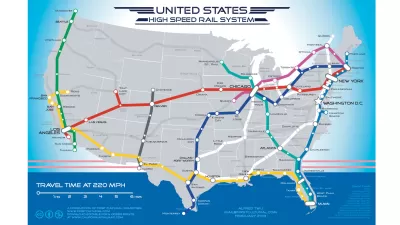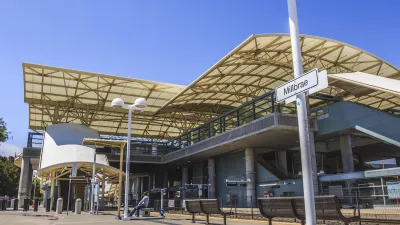If you guessed cheap gas, love of automobiles, or preference for air travel, you are correct, but those fall under one reason, "lack of demand." Two additional reasons are offered in this article for the construction industry.

Regulatory hurdles, eminent domain/land acquisition obstacles, and lack of demand are the main reasons why the United States is one of the few industrialized nations lacking high-speed rail, according to Kim Slowey, construction industry writer for Construction Drive.
- Regulatory hurdles
For starters, Harnish said the country's Buy America laws — remnants of the $50 billion General Motors Great Recession bailout — are preventing high-speed rail cars from being imported into the country, as there are currently no manufacturers producing them in the U.S.
In fact, this was the key regulation cited by China Railway International (CRI) last month for dropping interest in the Southern California-to-Las Vegas venture, XpressWest (previously called DesertXpress). So much for the $100 million they had planned to invest in California's 'second' high-speed rail line.
But even if the Buy America rules were not in place, cars made in other countries don't meet American safety standards as set by the Federal Railroad Administration. Rail cars made in the U.S. are designed to protect automobile passengers in case of a crash rather than the rail passengers, the opposite of the way cars are designed in many other countries, said Richard Harnish, executive director of the Midwest High-Speed Rail Association, an advocacy group based in Chicago.
"Our regulations create a train that is really heavy, so it's much more likely to get into an accident," he said...
The weight of SEPTA's new Silverliner V cars may have contributed to the reason why 120 were taken out of service.
- Eminent domain and land acquisition obstacles
Stowey cites land acquisition problems that delayed construction of the nation's only high-speed rail that finally broke ground in January of last year. The bond measure that authorized the now-$63 billion project passed in November 2008.
The [California High-Speed Rail Authority's] inability to secure enough property for contractor Tutor Perini to begin work in 2013 resulted in nearly $64 million in change orders [including $50 million in delay charges] to pay for the mobilization and remobilization of equipment.
Eminent domain is an issue in Texas as well, inspiring the group, Texans Against High-Speed Rail.
- Is demand too low?
Preference of Americans for driving and flying fall into this category, and cheap gas only makes driving more attractive, as we've seen on Labor Day, Memorial Day and Independence Day holiday weekends. And last year broke the record set in 2007 for greatest vehicle-miles-traveled.
Federal Highway Administration and Federal Transit Administration demand models "assume 'a very steep growth curve for future driving,'" states Harnish, although he questions it.
Harnish said the successful completion of at least one project is critical to the future of high-speed rail in the U.S. "That's why California is so important," he said. "Get that thing running trains."
2029 seems like too long to wait. Texas Central Railway should be operational between Dallas and Houston by 2021. Higher-speed, diesel-powered trains traveling at speeds up to 125 mph or 110 mph, respectively, should be in operation next year in Florida between West Palm Beach and Miami and in Illinois and Missouri between Chicago and St. Louis.
Hat tip to Len Conly
FULL STORY: Off the rails: Why high-speed train service has failed to gain traction in the US

Planetizen Federal Action Tracker
A weekly monitor of how Trump’s orders and actions are impacting planners and planning in America.

The Simple Legislative Tool Transforming Vacant Downtowns
In California, Michigan and Georgia, an easy win is bringing dollars — and delight — back to city centers.

San Francisco's School District Spent $105M To Build Affordable Housing for Teachers — And That's Just the Beginning
SFUSD joins a growing list of school districts using their land holdings to address housing affordability challenges faced by their own employees.

In More Metros Than You’d Think, Suburbs are Now More Expensive Than the City
If you're moving to the burbs to save on square footage, data shows you should think again.

The States Losing Rural Delivery Rooms at an Alarming Pace
In some states, as few as 9% of rural hospitals still deliver babies. As a result, rising pre-term births, no adequate pre-term care and "harrowing" close calls are a growing reality.

The Small South Asian Republic Going all in on EVs
Thanks to one simple policy change less than five years ago, 65% of new cars in this Himalayan country are now electric.
Urban Design for Planners 1: Software Tools
This six-course series explores essential urban design concepts using open source software and equips planners with the tools they need to participate fully in the urban design process.
Planning for Universal Design
Learn the tools for implementing Universal Design in planning regulations.
Smith Gee Studio
City of Charlotte
City of Camden Redevelopment Agency
City of Astoria
Transportation Research & Education Center (TREC) at Portland State University
US High Speed Rail Association
City of Camden Redevelopment Agency
Municipality of Princeton (NJ)





























